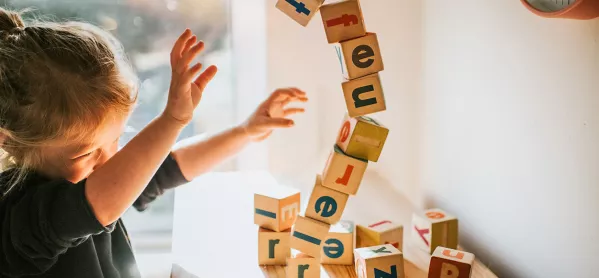The proportion of 4- and 5-year-olds judged to have reached expected levels of learning at the end of Reception plummeted compared to levels achieved before the pandemic, new government data has revealed.
Under two-thirds of pupils (63.4 per cent) were marked as being at the expected level across all early years foundation stage (EYFS) 17 learning goals at the end of the 2021-22 academic year, compared to 70.7 per cent in 2019.
And less than half of disadvantaged pupils were assessed to be at expected levels of learning across all areas.
In 2022, 47.1 per cent of pupils eligible for free school meals achieved the expected level across all early learning goals compared to 67 per cent of pupils not known to be eligible for free school meals.
Literacy was the lowest performing area, with 68 per cent of pupils achieving the expected standard, while physical development saw the highest percentage at the expected level of development (84.9 per cent).
The EYFS assessment is based on teachers’ observations of their pupils covering a wide range of learning and development.
Today’s results are the first to be published since the EYFS reforms were introduced in September 2021, which removed the “exceeding” category so pupils could only be marked as “at” or “below” the expected standard.
Schools were not required to complete the EYFS profile in 2021 and 2020, because of the Covid crisis.
Last year, the Department for Education instead asked schools to “make their best endeavours” to complete the assessment.
The proportion of children who achieved a “good level of development” at the end of Reception has also fallen from 71.8 per cent in 2018-19 to 65.2 per cent in 2021-22.
Those who reach a good level of development are those that are in the 12 early learning goals within the five areas of learning relating to: communication and language; personal, social and emotional development; physical development; literacy; and mathematics.
In 2022, 49.1 per cent of pupils eligible for free school meals achieved a good level of development across all early learning goals, compared to 65.2 per cent of their peers.
And far more girls than boys were at a good level of development across all early learning goals and areas of learning - 71.9 per cent compared to 58.7 per cent.
What is the EYFS profile?
The EYFS is the period of learning from birth to age 5 - before key stage 1 begins in Year 1.
The EYFS profile is an assessment of children’s achievements at the end of the Reception year - the last year of the EYFS.
Children are assessed against 17 early learning goals. The child’s profile will include whether children are below, or at these goals - known as emerging or reaching the expected level by the end of the Reception year.
What’s next for the EYFS profile?
Last year the government published its changes to the early learning goals after being piloted and consulted on in the sector.
The proposals are expected to ease the burden of the moderation process and enable teachers to “make a rounded judgement about a child’s development”.




